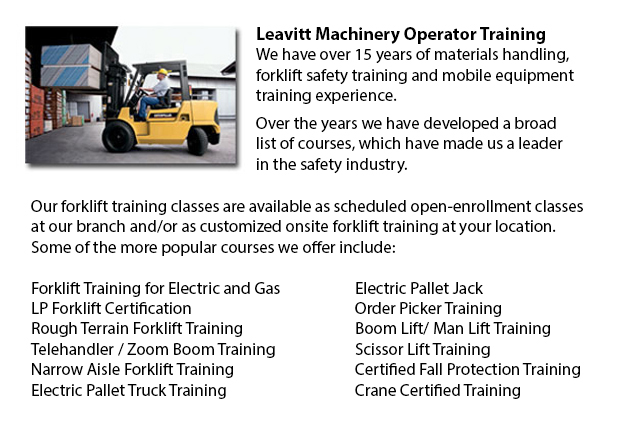
Rough Terrain Forklifts Training Richmond Hill - There are actually two kinds of forklifts within the manufacturing industry, the rough terrain model and the industrial version. Rough terrain lift trucks appeared in the 1940's designed primarily for use on uneven surfaces, perfect for lumberyards and building sites, providing lifting muscle when there was no paved surface existing.
Typically, most rough terrain lift trucks are run on a propane, diesel or gasoline driven internal combustion engines with a battery used for power. Several makers are experimenting with rough ground forklifts that consume vegetable matter and run from ethanol. Large pneumatic tires with deep treads typify these vehicles to allow them to grab onto the roughest ground type without any misstep or shifting.
The most basic models of all terrain forklifts were able to carry weights of up to 1000 lbs, using forks that could run under the item, jack it a slight bit and then move it to another location. After a decade on the market, rough terrain vehicles had been given supplementary shipping strength to about 2000 lbs capacity. In the 1960's telescoping booms were added, enabling them to stack materials a great deal higher than in preceding years. The telescoping model feature is a staple of nearly all all terrain forklifts at the moment. Present models are capable of handling well over 4000 lbs due to the continual enhancements through the years. Telescoping ability has also improved with some designs reaching a height of 35 feet. Worker safety has also become a focus with some rough terrain lift trucks currently built are fitted with an enclosed cab for the driver, versus the older open air seating capacity.
The all terrain lift trucks on the market nowadays both work admirably on unpaved roads and paved floors. This type of rough terrain lift truck is marketed for its' flexibility enabling the possibility for companies to utilize one unit to carry materials from an outside working area into a warehouse.
-
Hyster Forklift
Hyster Forklift Training Richmond Hill - As a global leader in forklift trucks, Hyster continually strives for excellence in product quality and safety. However, it began as a producer of lifting machinery as well as winches. Most of its production... More -
Nissan Forklift
Nissan Forklift Training Richmond Hill - Nissan takes immense pleasure in achieving total customer satisfaction, when their consumer is experiencing one of their many products including cars, trucks, and lift trucks. Nissan Motor Co. Ltd is the paren... More -
Scissor Pallet Trucks
Scissor Pallet Truck Training Richmond Hill - Scissor pallet vehicles are made for transporting and lifting individually stacked pallets by integrating a raising mechanism that enables the pallets on the truck to be elevated. This apparatus is a firs... More -
Pneumatic Forklifts
Pneumatic Forklifts Training Richmond Hill - Pneumatic jacks are often called pallet trucks or pump trucks and are widely utilized in warehouses and transport facilities to transport materials on pallets. Pneumatic jacks comprises a set of steel blad... More -
Aerial Lifts
Aerial Lift Training Richmond Hill - Aerial forklifts might be utilized to accomplish certain distinctive tasks executed in hard to reach aerial places. Some of the duties associated with this type of lift include performing routine repair on buildin... More

Forklift Training Richmond Hill
TOLL FREE: 1-888-254-6157
Richmond Hill, Ontario
forklifttrainingrichmondhill.com
Email Us
About Us


